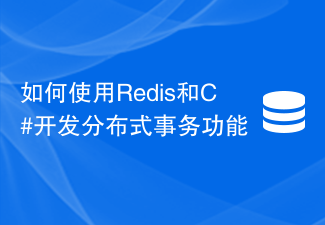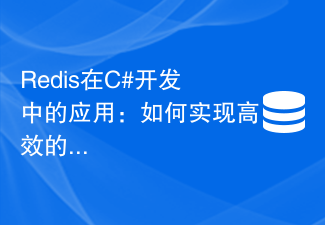 Backend Development
Backend Development C#.Net Tutorial
C#.Net Tutorial A preliminary study on the multi-threading mechanism of C# (3)
A preliminary study on the multi-threading mechanism of C# (3)What we should note here is that other threads are attached to the thread where the Main() function is located. The Main() function is the entrance to the C# program. The starting thread can be called the main thread. If all foreground threads are stopped , then the main thread can be terminated, and all background threads will be terminated unconditionally. Although all threads are executed serially from a micro perspective, you can think of them as executing in parallel from a macro perspective.
Readers must have noticed the property Thread.ThreadState. This property represents the running state of the thread and has different values under different circumstances. Therefore, we can sometimes design the program flow by judging the value. The possible values of ThreadState in various situations are as follows:
Aborted: The thread has stopped
AbortRequested: The thread's Thread.Abort() method has been called, but the thread has not stopped yet
Background: The thread is executed in the background, and the attribute Thread .IsBackground related
Running: The thread is running normally
Stopped: The thread has been stopped
StoPRequested: The thread is being asked to stop
Suspended: The thread has been suspended (in this state, it can be re-run by calling the Resume() method)
SuspendRequested : The thread is requesting to be suspended, but there is no time to respond.
Unstarted: Thread.Start() is not called to start the running of the thread.
WaitSleepJoin: The thread is in a blocked state because it calls methods such as Wait(), Sleep() or Join().
As mentioned above, the Background status indicates that the thread is running in the background, so what is special about the thread running in the background? In fact, there is only one difference between background threads and foreground threads, that is, background threads do not prevent the termination of the program. Once all foreground threads of a process have terminated, the CLR (Common Language Runtime Environment) will completely terminate the process by calling the Abort() method of any surviving background process.
When threads compete for CPU time, the CPU provides services according to the priority of the thread. In C# applications, users can set 5 different priorities, from high to low, namely Highest, AboveNormal, Normal, BelowNormal, and Lowest. If the priority is not specified when creating a thread, the system defaults to ThreadPriority.Normal. . To assign a priority to a thread
, we can use the following code:
//Set the priority to the lowest
myThread.Priority=ThreadPriority.Lowest;
By setting the priority of the thread, we You can arrange for some relatively important threads to be executed first, such as responding to users and so on.
Now that we have a preliminary understanding of how to create and control a thread, we will delve into the more typical problems in thread implementation and explore their solutions.
3. Thread synchronization and communication - producers and consumers
Assume a situation where two threads maintain a queue at the same time. If one thread adds elements to the queue, and the other thread removes elements from the queue To retrieve elements, we call the thread that adds elements a producer, and the thread that retrieves elements a consumer. The producer-consumer problem seems simple, but it is a problem that must be solved in multi-threaded applications. It involves synchronization and communication issues between threads.
As mentioned earlier, each thread has its own resources, but the code area is shared, that is, each thread can execute the same function. However, in a multi-threaded environment, a possible problem is that several threads execute a function at the same time, causing data confusion and unpredictable results. Therefore, we must avoid this situation. C# provides a keyword lock, which can define a section of code as a mutually exclusive section (critical section). The mutually exclusive section allows only one thread to enter execution at a time, while other threads must wait. In C#, the keyword lock is defined as follows:
lock(expression) statement_block
The above is the content of the preliminary exploration of C#’s multi-threading mechanism (3). For more related content, please pay attention to the PHP Chinese website (www.php.cn )!
 如何使用C#编写时间序列预测算法Sep 19, 2023 pm 02:33 PM
如何使用C#编写时间序列预测算法Sep 19, 2023 pm 02:33 PM如何使用C#编写时间序列预测算法时间序列预测是一种通过分析过去的数据来预测未来数据趋势的方法。它在很多领域,如金融、销售和天气预报中有广泛的应用。在本文中,我们将介绍如何使用C#编写时间序列预测算法,并附上具体的代码示例。数据准备在进行时间序列预测之前,首先需要准备好数据。一般来说,时间序列数据应该具有足够的长度,并且是按照时间顺序排列的。你可以从数据库或者
 如何使用Redis和C#开发分布式事务功能Sep 21, 2023 pm 02:55 PM
如何使用Redis和C#开发分布式事务功能Sep 21, 2023 pm 02:55 PM如何使用Redis和C#开发分布式事务功能引言分布式系统的开发中,事务处理是一项非常重要的功能。事务处理能够保证在分布式系统中的一系列操作要么全部成功,要么全部回滚。Redis是一种高性能的键值存储数据库,而C#是一种广泛应用于开发分布式系统的编程语言。本文将介绍如何使用Redis和C#来实现分布式事务功能,并提供具体代码示例。I.Redis事务Redis
 如何实现C#中的人脸识别算法Sep 19, 2023 am 08:57 AM
如何实现C#中的人脸识别算法Sep 19, 2023 am 08:57 AM如何实现C#中的人脸识别算法人脸识别算法是计算机视觉领域中的一个重要研究方向,它可以用于识别和验证人脸,广泛应用于安全监控、人脸支付、人脸解锁等领域。在本文中,我们将介绍如何使用C#来实现人脸识别算法,并提供具体的代码示例。实现人脸识别算法的第一步是获取图像数据。在C#中,我们可以使用EmguCV库(OpenCV的C#封装)来处理图像。首先,我们需要在项目
 如何使用C#编写动态规划算法Sep 20, 2023 pm 04:03 PM
如何使用C#编写动态规划算法Sep 20, 2023 pm 04:03 PM如何使用C#编写动态规划算法摘要:动态规划是求解最优化问题的一种常用算法,适用于多种场景。本文将介绍如何使用C#编写动态规划算法,并提供具体的代码示例。一、什么是动态规划算法动态规划(DynamicProgramming,简称DP)是一种用来求解具有重叠子问题和最优子结构性质的问题的算法思想。动态规划将问题分解成若干个子问题来求解,通过记录每个子问题的解,
 Redis在C#开发中的应用:如何实现高效的缓存更新Jul 30, 2023 am 09:46 AM
Redis在C#开发中的应用:如何实现高效的缓存更新Jul 30, 2023 am 09:46 AMRedis在C#开发中的应用:如何实现高效的缓存更新引言:在Web开发中,缓存是提高系统性能的常用手段之一。而Redis作为一款高性能的Key-Value存储系统,能够提供快速的缓存操作,为我们的应用带来了不少便利。本文将介绍如何在C#开发中使用Redis,实现高效的缓存更新。Redis的安装与配置在开始之前,我们需要先安装Redis并进行相应的配置。你可以
 C#开发中如何处理跨域请求和安全性问题Oct 08, 2023 pm 09:21 PM
C#开发中如何处理跨域请求和安全性问题Oct 08, 2023 pm 09:21 PMC#开发中如何处理跨域请求和安全性问题在现代的网络应用开发中,跨域请求和安全性问题是开发人员经常面临的挑战。为了提供更好的用户体验和功能,应用程序经常需要与其他域或服务器进行交互。然而,浏览器的同源策略导致了这些跨域请求被阻止,因此需要采取一些措施来处理跨域请求。同时,为了保证数据的安全性,开发人员还需要考虑一些安全性问题。本文将探讨C#开发中如何处理跨域请
 如何实现C#中的图像压缩算法Sep 19, 2023 pm 02:12 PM
如何实现C#中的图像压缩算法Sep 19, 2023 pm 02:12 PM如何实现C#中的图像压缩算法摘要:图像压缩是图像处理领域中的一个重要研究方向,本文将介绍在C#中实现图像压缩的算法,并给出相应的代码示例。引言:随着数字图像的广泛应用,图像压缩成为了图像处理中的重要环节。压缩能够减小存储空间和传输带宽,并能提高图像处理的效率。在C#语言中,我们可以通过使用各种图像压缩算法来实现对图像的压缩。本文将介绍两种常见的图像压缩算法:
 如何实现C#中的遗传算法Sep 19, 2023 pm 01:07 PM
如何实现C#中的遗传算法Sep 19, 2023 pm 01:07 PM如何在C#中实现遗传算法引言:遗传算法是一种模拟自然选择和基因遗传机制的优化算法,其主要思想是通过模拟生物进化的过程来搜索最优解。在计算机科学领域,遗传算法被广泛应用于优化问题的解决,例如机器学习、参数优化、组合优化等。本文将介绍如何在C#中实现遗传算法,并提供具体的代码示例。一、遗传算法的基本原理遗传算法通过使用编码表示解空间中的候选解,并利用选择、交叉和


Hot AI Tools

Undresser.AI Undress
AI-powered app for creating realistic nude photos

AI Clothes Remover
Online AI tool for removing clothes from photos.

Undress AI Tool
Undress images for free

Clothoff.io
AI clothes remover

AI Hentai Generator
Generate AI Hentai for free.

Hot Article

Hot Tools

SublimeText3 Chinese version
Chinese version, very easy to use

Dreamweaver Mac version
Visual web development tools

WebStorm Mac version
Useful JavaScript development tools

Notepad++7.3.1
Easy-to-use and free code editor

SecLists
SecLists is the ultimate security tester's companion. It is a collection of various types of lists that are frequently used during security assessments, all in one place. SecLists helps make security testing more efficient and productive by conveniently providing all the lists a security tester might need. List types include usernames, passwords, URLs, fuzzing payloads, sensitive data patterns, web shells, and more. The tester can simply pull this repository onto a new test machine and he will have access to every type of list he needs.





